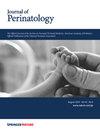Gestational diabetes detection thresholds and infant growth, nutrition, and neurodevelopment at 12-18 months: a prospective cohort study within a randomized trial
IF 2.4
3区 医学
Q2 OBSTETRICS & GYNECOLOGY
引用次数: 0
Abstract
To assess the impact of gestational diabetes(GDM) detection thresholds on infant growth, nutrition, and neurodevelopment at 12-18 months. Prospective cohort study within the GEMS trial(ACTRN12615000290594), which randomized pregnant women to detection of GDM using lower or higher glycemic criteria. The main outcomes were overweight/rapid weight gain; food approach appetitive score; energy intake; cognitive z-score. Compared to control infants, those exposed to GDM detected and treated by higher criteria or by lower but not higher criteria that was untreated, were less likely to have increased overweight/rapid weight gain, possibly with lower energy intake. There were no important differences in appetite and cognition. Infants exposed to GDM by lower but not higher criteria that was treated were similar to controls. Exposure to treated GDM or untreated GDM detected by lower but not higher criteria, was not associated with increased infant risk factors for obesity or adverse cognitive outcomes.妊娠糖尿病检测阈值与12-18个月婴儿生长、营养和神经发育:一项随机试验中的前瞻性队列研究
目的:评估妊娠期糖尿病(GDM)检测阈值对12-18个月婴儿生长、营养和神经发育的影响。设计:GEMS试验(ACTRN12615000290594)中的前瞻性队列研究,随机分配孕妇使用较低或较高的血糖标准检测GDM。主要结局为超重/体重快速增加;食物接近食欲得分;能量摄入;认知z分数。结果:与对照婴儿相比,那些暴露于GDM的婴儿,检测和治疗的标准较高,或较低但不高的标准,未经治疗,增加超重/快速体重增加的可能性较小,可能是较低的能量摄入。在食欲和认知方面没有显著差异。以较低而不是较高标准暴露于GDM的婴儿与对照组相似。结论:暴露于治疗过的GDM或未治疗的GDM,与婴儿肥胖或不良认知结局的危险因素增加无关。
本文章由计算机程序翻译,如有差异,请以英文原文为准。
求助全文
约1分钟内获得全文
求助全文
来源期刊

Journal of Perinatology
医学-妇产科学
CiteScore
5.40
自引率
6.90%
发文量
284
审稿时长
3-8 weeks
期刊介绍:
The Journal of Perinatology provides members of the perinatal/neonatal healthcare team with original information pertinent to improving maternal/fetal and neonatal care. We publish peer-reviewed clinical research articles, state-of-the art reviews, comments, quality improvement reports, and letters to the editor. Articles published in the Journal of Perinatology embrace the full scope of the specialty, including clinical, professional, political, administrative and educational aspects. The Journal also explores legal and ethical issues, neonatal technology and product development.
The Journal’s audience includes all those that participate in perinatal/neonatal care, including, but not limited to neonatologists, perinatologists, perinatal epidemiologists, pediatricians and pediatric subspecialists, surgeons, neonatal and perinatal nurses, respiratory therapists, pharmacists, social workers, dieticians, speech and hearing experts, other allied health professionals, as well as subspecialists who participate in patient care including radiologists, laboratory medicine and pathologists.
 求助内容:
求助内容: 应助结果提醒方式:
应助结果提醒方式:


